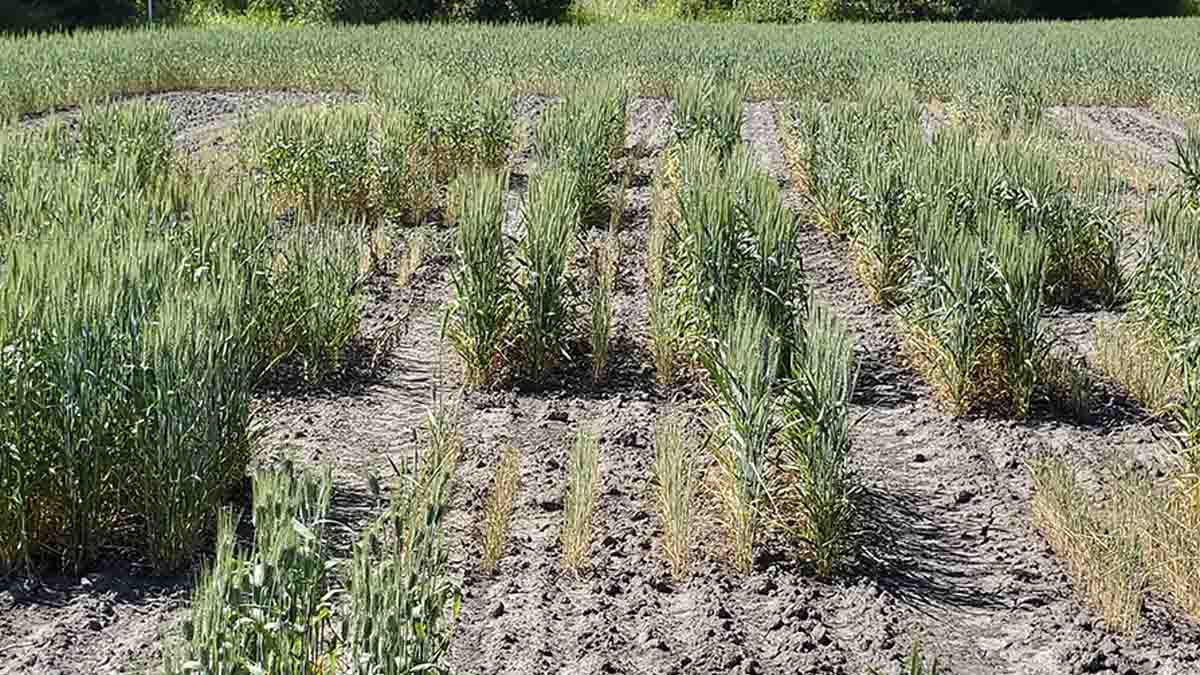Liming Trials
February 19, 2025
Separate University of Idaho research projects conducted over several years in eastern Idaho and northern Idaho have both concluded applying lime to raise soil pH can be a cost-effective approach toward improving crop yields.
Assistant Professor and Extension Specialist Jared Spackman, a barley agronomist, has been conducting laboratory experiments and trials in eastern Idaho commercial farm fields since 2021 aimed at developing recommendations to help the region’s farmers optimize the timing and volume of lime applications to best fit their management practices, climate and soil type.
In northern Idaho, Kurt Schroeder, an associate professor and Extension specialist and cropping systems agronomist is entering his ninth year of lime-application research. He’s found that most farmers in his region who are losing yields due to acidic soils stand to recoup their investment in a lime application within three to nine years, depending on the tonnage of lime they’ve used.
In chemistry, pH — short for potential of hydrogen — is a logarithmic scale ranging from zero to 14, in which seven is neutral, lower numbers represent acidity and higher numbers denote alkalinity.
Fertilizer applications, nutrient leaching caused by rainfall or irrigation, the harvest of high-yielding crops and the loss of soil organic matter can contribute to acidifying fields, thereby stunting root development of crops and limiting yields. Amalgamated Sugar Co. generates large volumes of lime as a byproduct of refining sugarbeets and supplies the material to many eastern Idaho growers, most of whom apply it to acidic fields every five years.
“What really got this study going is growers were telling me they apply anywhere from 1 to 4 tons of lime per acre, but they really didn’t know if that was the right amount or how long it lasted,” Spackman said. “Do our soils perform the same as the other soils around us or in the Midwest? The eastern Idaho calibration has never been done as far as I can find.”
Aluminum — which is toxic to plants, causing root damage and interfering with normal growth — becomes soluble in a form plants can absorb in acidic soils. Free aluminum and iron bind to soil phosphate reducing phosphorus availability to the crop. Nutrients including potassium, calcium and magnesium may also leach out of acidic soils further reducing soil pH. A pH of 6 to 6.5 is conducive to growing most crops. Yields begin to decline when soil pH is below 6 for alfalfa, 5.4 for barley and 5.2 for wheat.
Spackman has offered eastern Idaho growers who apply lime a few general guidelines based on his research thus far.
“Eastern Idaho’s acidic soils that start out at a pH of 5 to 5.4 will likely benefit from 2 to 4 tons of lime per acre and will rapidly remediate soil up to a pH of 6 to 6.5 in the top 6 inches, and the effects will likely last three to six years before another lime application is required,” Spackman said. Spackman started the study with a $75,000 grant from the Idaho Wheat Commission, covering research from 2021 through 2023. Two years into the project, he obtained $50,000 from the Idaho Barley Commission and $75,000 from the U.S. Department of Agriculture Western Sustainable Agriculture, Research and Education (SARE) program, funding liming research through 2026.
In addition to on-farm field studies, Spackman is conducting laboratory experiments. He collected samples of acidic soils with different textures from commercial farm fields in Fremont, Power and Caribou counties in eastern Idaho — as well as Latah County in northern Idaho for comparison. He applied lime in the form of pure calcium carbonate to the potted soil samples at rates ranging from the equivalent of zero tons per acre to 8 tons per acre and recorded how the pH responded in soils with textures of loamy sand, silt loam, loam and clay loam.
Spackman also applied lime at different rates to strips within four commercial fields in both counties in 2021, asking landowners to continue farming them as usual. He applied lime to strips in five additional commercial fields in 2023.
In those strip trials, pH changes have tended to last longer in clay soils, but it’s taken more lime to raise the pH. Spackman advises applying lower rates of lime more frequently on sandy soils. He’s observed in his strip trials that it may take two to three years for liming to significantly improve yields.
Soil moisture is needed for lime to affect pH, making the optimal time to apply lime, especially on dryland farms, during the fall before the winter snowpack accumulates.
Many farmers associate problems with certain weeds with low soil pH. Spackman conducted a greenhouse study in which he planted several weed species in pots of varying pH levels and soil types to determine if a lower pH invigorated any of the weed species. Having noticed no difference in weed growth across pH levels, he plans to have an intern conduct a new study next spring, planting both weeds and barley plants in common pots. Spackman hypothesizes that the combination of a lower pH and competition with weeds that aren’t affected by pH changes will severely stunt barley growth.
In a survey of 125 fields across eight northern Idaho counties conducted a decade ago, Schroeder and Doug Finkelnburg, an area Extension educator and cropping systems agronomist, concluded 75% of fields had a pH of 5.2 or below in the top 6 inches of the soil and were at risk of developing issues with aluminum toxicity. Schroeder believes soil acidity is beginning to “nibble away” at yields in his region, and many growers have simply stopped planting sensitive crops such as barley in the most severely impacted fields.
Schroeder has documented increases in soil pH and consistent yield improvements where he’s applied lime, even eight years following the initial application. He’s noticed benefits beginning in the first season following fall lime applications and in the second season following spring lime applications.
Schroeder recently reviewed all his trial data and presented the results to a large group of growers and agronomists during a workshop, Liming for Long-term Gains, hosted Dec. 16 in Moscow.
The average winter wheat yield gains resulting from liming were 12% per year at the 1-ton rate, 16% at the 2-ton rate, and 19% at the 3-ton rate. In spring wheat, yield gains have averaged 11% at the 1-ton rate, 18% at the 2-ton rate and 24% at the 3-ton rate. Eight years following lime applications, Schroeder reported he’s still seen no evidence of soils in any of his trials reverting to their pre-liming acidity.
“We were expecting maybe by six to seven years we’d start to see pH start to decline again. We’re not seeing a clear trend of that happening,” Schroeder said.
Lime is incorporated within the top 6 inches of soil and doesn’t appear to move through the soil profile. Within the top 3 inches of soil where Schroeder has applied lime in his trials, soluble aluminum is essentially eliminated, and it’s reduced by three-fourths at 3- to 6-inch depth.
Schroeder advises his region’s growers experiencing challenges with acidic soils to diversify soil rotations, including legume crops, and implement variable-rate nitrogen applications in addition to liming. The cost of buying and transporting lime in northern Idaho, the fact that most farmers lack the equipment to spread lime sources and contractual challenges of applying lime on leased cropland all pose barriers to using lime as a tool in the region.
Spackman’s research is funded through 2026 with $75,000 from the U.S. Department of Agriculture Western Sustainable Agriculture, Research and Education (SARE) program under award No. OW23-382. The federal share represents about 38% of the total funding.

About the University of Idaho
The University of Idaho, home of the Vandals, is Idaho’s land-grant, national research university. From its residential campus in Moscow, U of I serves the state of Idaho through educational centers in Boise, Coeur d’Alene and Idaho Falls, nine research and Extension centers, plus Extension offices in 42 counties. Home to more than 12,000 students statewide, U of I is a leader in student-centered learning and excels at interdisciplinary research, service to businesses and communities, and in advancing diversity, citizenship and global outreach. U of I competes in the Big Sky and Western Athletic conferences. Learn more at uidaho.edu.






